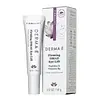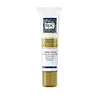What's inside
What's inside
 Key Ingredients
Key Ingredients

 Benefits
Benefits

 Concerns
Concerns

 Ingredients Side-by-side
Ingredients Side-by-side

Water
Skin ConditioningCaprylic/Capric Triglyceride
MaskingNiacinamide
SmoothingCoco-Caprylate
EmollientStearyl Alcohol
EmollientGlycerin
HumectantPropanediol
SolventLycium Barbarum Fruit Extract
AstringentGlyceryl Stearate
EmollientHamamelis Virginiana Extract
AntiseborrhoeicDiheptyl Succinate
EmollientCapryloyl Glycerin/Sebacic Acid Copolymer
Skin ConditioningCopernicia Cerifera Wax
Dimethyl Mea
BufferingHydroxypropyl Cyclodextrin
MaskingPalmitoyl Tripeptide-38
Skin ConditioningAcetyl Hexapeptide-8
HumectantSodium Hyaluronate
HumectantThioctic Acid
AntioxidantPanthenol
Skin ConditioningAscorbyl Palmitate
AntioxidantSimmondsia Chinensis Seed Oil
EmollientCaffeine
Skin ConditioningAllantoin
Skin ConditioningXanthan Gum
EmulsifyingGlyceryl Stearate Citrate
EmollientPhenoxyethanol
PreservativeEthylhexylglycerin
Skin ConditioningWater, Caprylic/Capric Triglyceride, Niacinamide, Coco-Caprylate, Stearyl Alcohol, Glycerin, Propanediol, Lycium Barbarum Fruit Extract, Glyceryl Stearate, Hamamelis Virginiana Extract, Diheptyl Succinate, Capryloyl Glycerin/Sebacic Acid Copolymer, Copernicia Cerifera Wax, Dimethyl Mea, Hydroxypropyl Cyclodextrin, Palmitoyl Tripeptide-38, Acetyl Hexapeptide-8, Sodium Hyaluronate, Thioctic Acid, Panthenol, Ascorbyl Palmitate, Simmondsia Chinensis Seed Oil, Caffeine, Allantoin, Xanthan Gum, Glyceryl Stearate Citrate, Phenoxyethanol, Ethylhexylglycerin
Water
Skin ConditioningGlycerin
HumectantLactose
HumectantC12-15 Alkyl Benzoate
AntimicrobialCetearyl Ethylhexanoate
EmollientPEG-100 Stearate
Glyceryl Stearate
EmollientPEG-8
HumectantStearyl Alcohol
EmollientTromethamine
BufferingPanthenol
Skin ConditioningCarbomer
Emulsion StabilisingIsopropyl Myristate
EmollientMethylparaben
PreservativeDisodium EDTA
BHT
AntioxidantPropylparaben
PreservativeMagnesium Aspartate
Skin ConditioningZinc Gluconate
Skin ConditioningChlorhexidine Digluconate
AntimicrobialRetinol
Skin ConditioningPolysorbate 20
EmulsifyingCopper Gluconate
Skin ConditioningWater, Glycerin, Lactose, C12-15 Alkyl Benzoate, Cetearyl Ethylhexanoate, PEG-100 Stearate, Glyceryl Stearate, PEG-8, Stearyl Alcohol, Tromethamine, Panthenol, Carbomer, Isopropyl Myristate, Methylparaben, Disodium EDTA, BHT, Propylparaben, Magnesium Aspartate, Zinc Gluconate, Chlorhexidine Digluconate, Retinol, Polysorbate 20, Copper Gluconate
Ingredients Explained
These ingredients are found in both products.
Ingredients higher up in an ingredient list are typically present in a larger amount.
Glycerin is already naturally found in your skin. It helps moisturize and protect your skin.
A study from 2016 found glycerin to be more effective as a humectant than AHAs and hyaluronic acid.
As a humectant, it helps the skin stay hydrated by pulling moisture to your skin. The low molecular weight of glycerin allows it to pull moisture into the deeper layers of your skin.
Hydrated skin improves your skin barrier; Your skin barrier helps protect against irritants and bacteria.
Glycerin has also been found to have antimicrobial and antiviral properties. Due to these properties, glycerin is often used in wound and burn treatments.
In cosmetics, glycerin is usually derived from plants such as soybean or palm. However, it can also be sourced from animals, such as tallow or animal fat.
This ingredient is organic, colorless, odorless, and non-toxic.
Glycerin is the name for this ingredient in American English. British English uses Glycerol/Glycerine.
Learn more about GlycerinGlyceryl Stearate is a mix of glycerin and stearic acid.
It is used to stabilize the mixing of water and oil ingredients. By preventing these ingredients from separating, it can help elongate shelf life. It can also help thicken the product's texture.
As an emollient, it helps soften skin and supports barrier-replenishing ingredients.
In cosmetics, Glyceryl Stearate is often made from vegetable oils or synthetically produced.
This ingredient may not be fungal-acne safe
Fun fact: The human body also creates Glyceryl Stearate naturally.
Learn more about Glyceryl StearatePanthenol is a common ingredient that helps hydrate and soothe the skin. It is found naturally in our skin and hair.
There are two forms of panthenol: D and L.
D-panthenol is also known as dexpanthenol. Most cosmetics use dexpanthenol or a mixture of D and L-panthenol.
Panthenol is famous due to its ability to go deeper into the skin's layers. Using this ingredient has numerous pros (and no cons):
Like hyaluronic acid, panthenol is a humectant. Humectants are able to bind and hold large amounts of water to keep skin hydrated.
This ingredient works well for wound healing. It works by increasing tissue in the wound and helps close open wounds.
Once oxidized, panthenol converts to pantothenic acid. Panthothenic acid is found in all living cells.
This ingredient is also referred to as pro-vitamin B5.
Learn more about PanthenolStearyl Alcohol is a type of fatty alcohol from stearic acid. It is a white, waxy compound used to emulsify ingredients.
Fatty Alcohols are most often used as an emollient or to thicken a product. Emollients help soothe and hydrate the skin by trapping moisture.
They are usually derived from natural fats and oils and therefore do not have the same drying or irritating effect as solvent alcohols. FDA allows products labeled "alcohol-free" to have fatty alcohols.
Learn more about Stearyl AlcoholWater. It's the most common cosmetic ingredient of all. You'll usually see it at the top of ingredient lists, meaning that it makes up the largest part of the product.
So why is it so popular? Water most often acts as a solvent - this means that it helps dissolve other ingredients into the formulation.
You'll also recognize water as that liquid we all need to stay alive. If you see this, drink a glass of water. Stay hydrated!
Learn more about Water